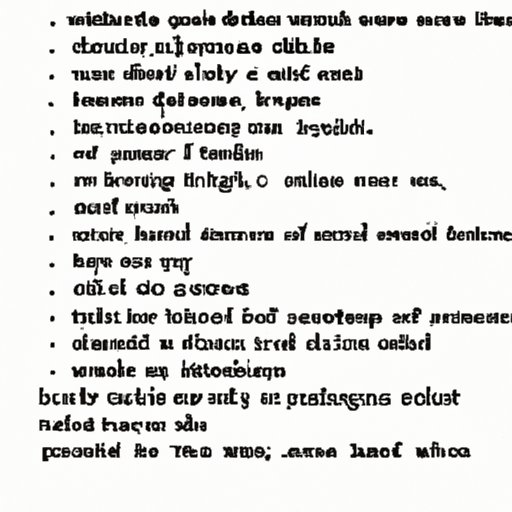Introduction
Poetry is a form of literary art in which the writer uses words to create images, emotions, and sounds. It is one of the oldest forms of literature, with roots going back centuries. Writing a poem can be an intimidating prospect, especially if you’re not sure where to start. However, there are several techniques and strategies you can use to get the creative juices flowing and craft an inspiring poem.
Creating a Vivid Image or Feeling
One of the most important elements of any poem is its ability to create a vivid image or feeling in the reader’s mind. To do this, poets must use vivid language to describe the subject of their poem. For example, rather than saying “the sun was bright,” they might say “the sun blazed like a raging inferno.” This type of language will allow the reader to truly visualize the scene being described.
In addition to using vivid language, poets should also try to paint a picture with their words. The best way to do this is by focusing on sensory details that evoke sight, sound, smell, taste, and touch. By including these details, the poet will be able to create a vivid, multi-sensory experience for the reader.
Asking a Question
Asking a question can be an effective way to draw the reader into the poem and make them think about the subject in a new way. Questions can be used to challenge the reader’s preconceptions or prompt them to consider something from a different perspective. They can also be used to create a sense of mystery or suspense.
When crafting a poem, it’s important to make sure the questions are thought-provoking and relevant to the subject matter. For example, if you’re writing a poem about love, you might ask “What is the true meaning of love?” This type of question will encourage the reader to reflect on the poem’s theme and will make them more invested in the story.
Metaphors and Similes
Metaphors and similes are powerful tools that poets can use to express ideas or emotions. A metaphor is a figure of speech in which two things that are not literally related are compared. For example, someone might say “the clouds were like giant cotton balls in the sky.” A simile is similar to a metaphor, except it explicitly uses the words “like” or “as” to compare two things.
Metaphors and similes can help a poet convey ideas or feelings in a unique and creative way. For example, if a poet wanted to express their sadness over a lost love, they might write “My heart felt like an empty void.” This type of language is much more effective than simply writing “I was sad.”

Unexpected Angles or Points of View
Exploring unexpected angles or points of view can be a great way to make your poem stand out. Rather than simply looking at the world through your own eyes, try to imagine the experience from someone else’s perspective. This could be a character in the poem, an animal, or even an inanimate object.
For example, if you’re writing a poem about a tree, you might explore what it would be like to be that tree. What does it feel like to be rooted in the ground? How does it feel when the wind blows through its branches? Taking this type of creative approach can help add an extra layer of depth to your poem.
Alliteration, Assonance, and Internal Rhyme
Alliteration, assonance, and internal rhyme are three techniques that poets can use to create a lyrical effect in their work. Alliteration is the repetition of the same sound at the beginning of multiple words. Assonance is the repetition of the same vowel sound in multiple words. Internal rhyme is the repetition of the same sound within a single line of poetry.
These techniques can be used to create a smoother, more melodic flow to the poem. For example, if you wanted to emphasize the idea of love, you could write “Lingering love lives lightly on my lips.” Here, the alliterative “L” sound and internal rhyme of “love” and “lives” creates a pleasingly rhythmic effect.
Onomatopoeia
Onomatopoeia is the use of words that imitate the sound they describe. Examples of onomatopoeia include “buzz,” “sizzle,” and “hiss.” These words can be used to capture the sound and mood of a particular moment or setting. For example, if you’re writing a poem about a thunderstorm, you might use onomatopoeia to describe the sound of thunder rolling across the sky.
By incorporating onomatopoeia into their work, poets can create a more immersive experience for their readers. This type of language allows the reader to really connect with the poem and better visualize the scene being described.
Conclusion
Writing a poem can be a daunting task, but by following these tips, you can craft a captivating poem that will engage and inspire your readers. Use vivid language to create a vivid image or feeling, ask questions to draw the reader in, explore different angles and perspectives, and incorporate metaphors, similes, alliteration, assonance, internal rhyme, and onomatopoeia to create a lyrical effect. With these strategies, you’ll be well on your way to creating a powerful and memorable poem.
(Note: Is this article not meeting your expectations? Do you have knowledge or insights to share? Unlock new opportunities and expand your reach by joining our authors team. Click Registration to join us and share your expertise with our readers.)
